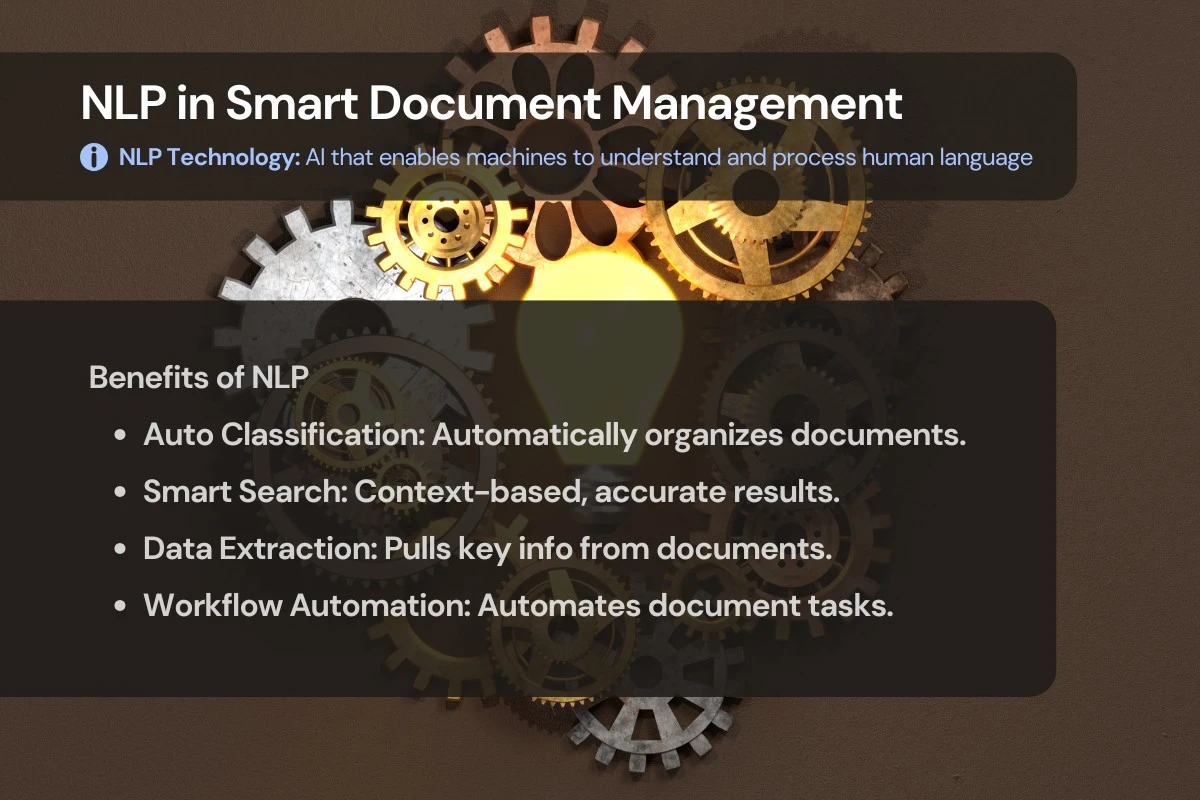How Is Natural Language Processing Transforming Smart Document Management?

Businesses are producing a huge number of documents, and handling them effectively can be a nightmare. Natural Language Processing, an AI-based branch, is revolutionizing document management systems by equipping machines with the capability to understand and interpret human language. From workflow automation to extracting insights, NLP is making document management smarter and more efficient.
1. What is Natural Language Processing?
NLP is a type of artificial intelligence that studies how computers and human language interact. It enables machines to read, understand, and derive meaning from text and speech, thus enhancing capabilities like classification, summarization, search optimization, and sentiment analysis in document management systems.
2. How is NLP changing document management systems?
- 2.1 Automated Document Classification: NLP-powered systems can classify documents automatically, such as invoices, contracts, and reports, saving human effort and avoiding errors. For instance, a system using NLP can recognize keywords like “invoice number” to classify the document properly.
- 2.2 Advanced Search Capabilities: Traditional search methods often fail to produce relevant results. NLP improves search because it comprehends context and intent. For example, the user can search, “Show me all invoices from Vendor A in March,” and NLP retrieves relevant documents even though the wording has varied.
- 2.3 Document Summarization: NLP can provide summaries of lengthy documents. A user will be able to easily understand key points through it. For instance, NLP can summarize a 50-page legal document and only mention the crucial clauses.
- 2.4 Intelligent Data Extraction: NLP can extract structured data from unstructured text like dates, names, and invoice amounts in order to speed up the processing of documents. It can also extract purchase order numbers from emails so that integration with ERP systems becomes smoother.
- 2.5 Sentiment Analysis: NLP analyzes text to detect sentiment, tone, and compliance issues, helping businesses identify risks and ensure compliance. For instance, NLP can analyze contracts to find clauses that may lead to disputes.
- 2.6 Automating Workflows: NLP streamlines workflows by triggering actions based on content, such as moving a document to the next step when the word “approved” is detected in an email.
3. Benefits of NLP in Document Management Systems
- 3.1 Improved Accuracy: NLP removes the possibility of human errors through data entry or classification.
- 3.2 Increased Efficiency: Automation of boring tasks leaves one with time to do more important things.
- 3.3 Better Search and Retrieval: Contextual, intelligent search makes it easy to locate documents.
- 3.4 Saves Labor Costs: Increases efficiency in operations.
- 3.5 Data-Driven Insights: Extraction of valuable information for better decision-making.

4. How to Select the Best Document Management Software Featuring NLP
When selecting document management software, look for systems that leverage NLP for features like:
- 4.1 Smart search and retrieval
- 4.2 Automatic classification and tagging
- 4.3 Intelligent data extraction
- 4.4 Workflow automation
- 4.5 Summarization tools
If you’re looking for the best document management software in India, you should look for solutions that integrate AI technologies like NLP to get ahead of the game.
5. How is MillionDox Helping Companies with Smart Document Management?
MillionDox, one of India’s leading document management software, is changing how companies handle their documents. Through advanced NLP abilities, MillionDox enables its customers to:
- 5.1 Automate classifications and organizations of documents.
- 5.2 Extract key information for decisions faster.
- 5.3 Optimize search and retrieval through context-based questions.
- 5.4 Automate workflows with more time saved and reducing human errors.
With MillionDox, companies can focus on growth, innovation, and efficiency while leaving behind document management headaches. Using smart technologies like NLP, MillionDox empowers companies to stay ahead in this fast-paced digital landscape.
6. Conclusion
Natural Language Processing plays a pivotal role in document management systems. With the ability to offer smarter classification, more advanced search, and auto workflows, NLP creates efficiency and innovation. For Indian companies looking for the best document management software, MillionDox and similar programs provide cutting-edge natural language processing (NLP) features to help optimize workflows and produce outstanding outcomes. Go smart with document management today, empowering your organization to win.
7. FAQ
- 7.1 What is Natural Language Processing (NLP)?
Natural Language Processing, or NLP, is a branch of artificial intelligence that allows computers to comprehend, interpret, and process human language. NLP equips machines with the capability to read, analyze, and extract meaningful information from text and speech in ways similar to human understanding. - 7.2 How does NLP enhance document management systems?
NLP enables enhanced management of documents through the automation of tasks like classification, data extraction, summarization, and enhancing search functionalities. It helps businesses categorize documents, retrieve relevant information, and analyze text—all factors that lead to increased efficiency and accuracy. - 7.3 Does NLP aid in the classification of documents?
Yes, computers with NLP abilities are able to automatically categorize documents according to their content. For example, invoices, contracts, or reports can be categorized without manual intervention, reducing errors and saving time. - 7.4 How does NLP improve document search capabilities?
NLP improves the functionality of search by taking into account context, synonyms, and user intent. The system no longer relies solely on exact keywords but instead uses natural language queries, such as “Show me all invoices from Vendor A in March,” to provide more accurate results. - 7.5 What is document summarization with NLP?
NLP document summarization automatically generates concise summaries from lengthy documents. This allows users to access key information without having to read through entire reports or contracts. - 7.6 How does NLP help in data extraction?
NLP can extract structured data, such as names, dates, and invoice amounts, from unstructured text like emails or PDFs. This speeds up document processing and makes it easier to integrate with other business systems like ERP. - 7.7 Can NLP determine the sentiment in documents?
Yes, it is possible to analyze sentiment or tone in a document, like contracts, employee feedback, or legal text. It allows businesses to better identify risks or compliance issues and get more valuable insights in decision-making. - 7.8 How does NLP enable automation of document management workflows?
NLP can automate repetitive tasks by triggering actions based on the content of the documents. For instance, an NLP system can identify that a document is marked “approved” and automatically move it to the next step in the workflow, thereby increasing efficiency.
To know more about this visit MillionDox.com